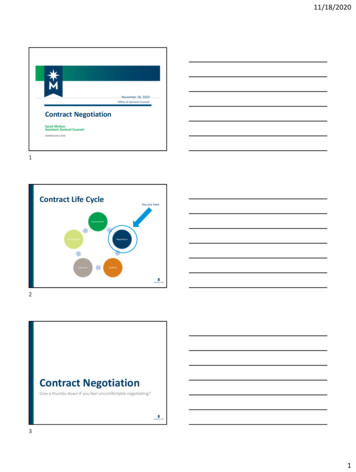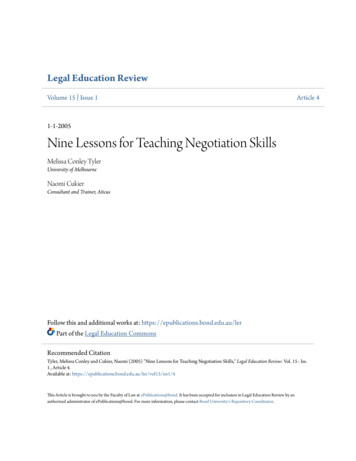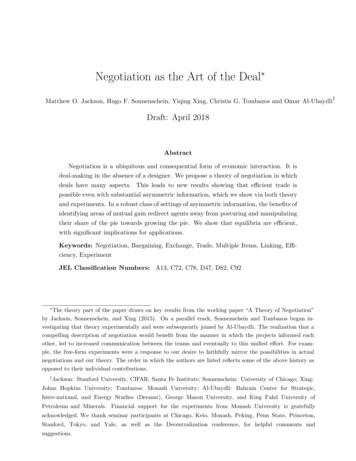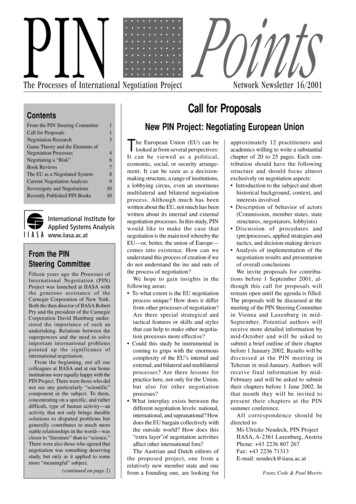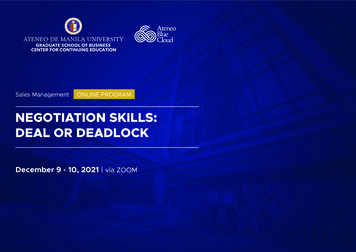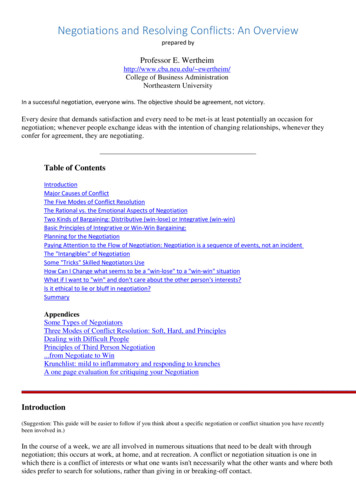
Transcription
Welcome to Negotiation &Contract Management - NVITBy: Gayle Bedard
Lax Kw’Alaams
N.V.I.T.(Nicola Valley Institute of Technology) Negotiation and Contract Management – 3 credit course Both negotiations and contract management are examinedin this course through experiential models and practices,focusing particularly on applications with a First Nationssetting. The learning process is based on a combination of lectureinputs to introduce core concepts, individual and classexercises organizational skills, and allows students tomonitor their own progress in the course. The students will be introduced to the concept of anchoringtheir learning with S.M.A.R.T. goal setting. This course is targeted for those who are employed and/orhave administrative experience.
Course SummaryThis course deals with negotiation andbargaining as methods of advancing andprotecting your own interests, and of resolvingdisagreements and conflicts. Throughout theweek, students will have the opportunity tolearn terms and concepts, acquire information,and develop skills, which experiencednegotiators have found to be useful. Theseopportunities will be presented in at least fivedifferent ways.
Resources for Course
NegotiationsTable Talk – What do we understand by the term“negotiation”?
Negotiation Means . . .“Negotiation involves two (or more) parties withcompeting or conflicting interests or needs,working towards an agreement on how they willco-operate” Dr. Gregory Tillett Resolving Conflict (Sydney: Sydney UniversityPress, 1991) p. 46.
Recent Negotiations . . .Think of some recent negotiations in which youhave been involved. What are they?
We Negotiate For . . . Buying a car, a house or an appliance Negotiating salary Negotiating different roles & responsibilities atwork Arranging a fair division of household chores Making divorce settlements and custodyarrangements Agreeing with child on video games, etc.
Why Do We Negotiate In TheseSettings? Variety of reasons depending on the situation There seems to be no alternative (people maynot otherwise be willing to shift) To reach an agreement To maintain or strengthen the relationship To be fair: to take account of both parties’perspectives, needs and concerns To get the best deal possible
Simulation Activity Human Resources Director / Prospective Employee Position: Computer Programmer Position
Negotiation Practise . . .
Negotiation / Conflict
Negotiation styles . . .
Negotiation / Conflict Negotiation often involves some degree ofconflict, whether you’re hashing out a potentiallyprofitable deal or trying to resolve a nastydispute. By nipping in the bud the impulse to becomeagitated, rapport between negotiators works as akind of social tranquilizer. Rapport determines whether negotiators developthe trust necessary to understand each other’sinterests and reach a strong agreement.
How the Body Responds toStress / Conflict
The Brain’s response . . .
Neuroscience and the Brain
The Brain
Trauma / Stress & Brain Development The brain develops from brainstem to the cortex. Infancy and childhood extremely important in braindevelopment – use it or lose it. By shaping the developing brain, experiences of childhooddefine the adult. Simply stated, children reflect the world in which they areraised. If that world is characterized by threat, chaos,unpredictability, fear and trauma, the brain will reflect thatby altering the development. With the history of Aboriginal peoples of Canada – howeffective are we at negotiations?
When stressed The Amygdala acts as thebrains “security guard”,protecting us from threats. This blocks the ability to usethe highest, reflective brain todetermine behavior anddecision making. The behavioral responses arelimited to fight/flight/freeze (acting outor zoning out).(www.RADteach.com)Judy Willis, MD,M.Ed
What is conflict?How would you describe it?
4 Classifications Intrapersonal conflict - a conflict that occurs solely inthe psychological dynamics of the person's own mind. Interpersonal conflict refers to a conflict between twoindividuals. Intragroup conflict is a type of conflict that happensamong individuals within a team. The incompatibilitiesand misunderstandings among these individuals leadto an intragroup conflict. Intergroup conflict takes place when amisunderstanding arises among different teams withinan organization.
How do people deal with conflict?(individual / group / community)How do you or people around you deal with conflict?
How do you respond to conflict . . .?Describe a conflict situation and end result . . .
Describe a successful conflict situation - end result . . .
Reflection . . . How often do I face conflict? When conflict occurs, do I prefer to avoid dealing with it orgive in to others? Do I come off too aggressively at times? Do I take time to listen to other people’s thoughts on anissue? When conflict emerges, am I aware of my feelings andthose of others? Do I rush to solve problems before I’m sure of what theissues are? Do I collaborate with others to come up with solutions, ordo I make most of the decisions on my own?
Discovering your conflict styles . . .in relationships
Complete the Thomas Killman InstrumentQuestionnaire
What is your style?Advantages / Disadvantages
Score your conflict assessment . . .
Take the hot buttons assessment . . .
Negotiation styles . . .
When do you negotiate?
The problem with negotiation . . .Don’t bargain over positionsPositional bargaining:Each side takes a position, argues for it and it aloneRegardless of any underlying issues.
Share an experience of . . .
Positional bargaining consequences: Arguing over positions produce unwiseoutcomes – your ego becomes identified withthe position. Arguing over positions is inefficient. Arguing over positions endangers an ongoingrelationship. When they are many parties, positionalbargaining is even worse. Being nice is no answer.
Positional Bargaining: What gameshould you play?
SoftHardParticipants are friendsParticipants are adversariesThe goal is agreementThe goal is victoryMake concessions to cultivate arelationshipDemand concessions as a condition of therelationshipBe soft on the people and problemBe hard on the problem and the peopleTrust othersDistrust othersChange your position easilyDig in your positionMake offersMake threatsDisclose your bottom lineMislead as your bottom lineAccept one sided offers to reachagreementDemand one-sided gains as the price ofagreementSearch for single answers: one they willacceptSearch for the single answer: the one youwill acceptInsist on agreementInsist on your positionTry to avoid contest of willsTry to win a contest of willYield to pressureApply pressureGetting to Yes, Fisher & Ury
SoftHardPrincipledParticipants are friendsParticipants are adversariesParticipants are problem solversThe goal is agreementThe goal is victoryThe goal is a wise outcomeMake concessions to cultivate arelationshipDemand concessions as a conditionof the relationshipSeparate people from the problemBe soft on the people andproblemBe hard on the problem and thepeopleBe soft on the people; hard on theproblemTrust othersDistrust othersProceed independent of trustChange your position easilyDig in your positionFocus on interests not positionsMake offersMake threatsExplore interestsDisclose your bottom lineMislead as your bottom lineAvoid having a bottom lineAccept one sided offers to reachagreementDemand one-sided gains as theprice of agreementInvent options for mutual gainSearch for single answers: onethey will acceptSearch for the single answer: theone you will acceptDevelop multiple options to choosefrom, decide laterInsist on agreementInsist on your positionInsist on using objective criteriaTry to avoid contest of willsTry to win a contest of willTry to reach a result based onstandards independent of willYield to pressureApply pressureReason and be open to reasons;yield to principle not pressureGetting to Yes, Fisher & Ury
Negotiating Success Model(Jim Hornickel)Based on 3 Principles:Mutuality(win / win)Proactivity(creative)Respect
R – responsiveness (to their and your needs) E – empathy (put yourself in their shoes) S – being of service to each other (think of customerservice) P – perspectives (point of view, belief, or opinion) E – esteem (the state of one’s self-worth) C – courage – (the ability to move through discomfortand uncertainty on behalf of a win-win negotiation T – truth telling (avoidance of lying, deception,misrepresentation, and nondisclosure
Activity Using the S.M.A.R.T. acronym – develop a goal.– Specific Measurable–Attainable / Achievable»Relevant Timely
There is an alternative to positionalbargaining . . .
Separate people from the problem . . . Negotiators are people first They have emotions, deeply held values, anddifferent backgrounds and viewpoints; andthey are unpredictable. Every negotiator wants to reach an agreementthat satisfies his substantive interests. A negotiator wants to maintain a workingrelationship good enough to produce anacceptable agreement.
How Good Are Your Listening Skills?
The Power of Listening – Uryhttps://www.youtube.com/watch?v saXfavo1OQo
Analyze Their Perceptions Understand the other person’s thinking – becausetheir thinking is the problem. Put yourself in their shoes. The ability to see the situation as the other sidesees it, as difficult as it may be, is one of the mostimportant skills a negotiator can possess! Don’t blame them for your problem. Discuss each other’s perceptions. Effective communication
Focus on interests, not positions Interests define the problem. The basic problem in a negotiation lies not inthe conflicting positions, but in the conflictbetween each sides needs, desires, concerns,and fears. Behind opposed positions lie shared andcompatible interests, as well as conflictingones. How do you identify interests?
Invent multiple options . . .
Insist that the result . . . Be based on some objective standard. Principled negotiation produces wiseagreements amicably and efficiently. The more you bring standards of fairness andefficiency, the more likely you will reach a fairand acceptable agreement.
BATNA BestAlternativeToANegotiatedAgreement This is the only standard that can protect youfrom both accepting terms that are unfavorable.
In negotiation, it’s important to have highaspirations and to fight hard for a goodoutcome. But it’s just as critical to establish awalkaway point that is firmly grounded inreality.
Assessing your BATNA. To determine your BATNA in agiven negotiation, follow these four steps: List your alternatives. Think about all the alternativesavailable to you if the current negotiation ends in animpasse. What are your no-deal options? Evaluate your alternatives. Examine each option andcalculate the value of pursuing each one. Establish your BATNA. Choose a course of action thatwould have the high- est expected value for you. This isyour BATNA—the course you should pursue if thecurrent negotiation fails.
Calculate your reservation value. Now that youknow your BATNA, calculate your reservationvalue—the lowest-valued deal you are willing toaccept. If the value of the deal proposed to you is lowerthan your reservation value, you’ll be better offrejecting the offer and pursuing your BATNA. If the final offer is higher than your reservationvalue, you should accept it.
Taking your BATNA to the next level and gain a critical advantage in upcomingdeals. 1. Translate your BATNA to the current deal.
Generating BATNA’s Inventing a list of actions you mightconceivably take if no agreement is reached. Improving some of the more promising ideasand converting them into practicalalternatives; and Selecting, tentatively, the one alternative thatseems best.
Summary of today’s class . . . How does the body respond to conflict? The definition of conflict? Why is it important for self-awareness inconflict? The 5 conflict styles of Thomas Killman are . . . Negotiation means . . . Positional bargaining means What does BATNA mean?
Covey – One of the 7 Habits of Highly EffectivePeople “Seek first to understand”: We (as educators) typically seekfirst to be understood. Most people do not listen with theintent to understand; they listen with the intent to reply.”They’re either speaking or preparing to speak. They’refiltering everything through their own paradigms, reading theirown autobiography into other people’s lives.” Empathic listening (the highest form of listening). Listeningwith intent to understand. I mean seeking first to understand;to really understand.
4 Classifications Intrapersonal conflict - a conflict that occurs solely in the psychological dynamics of the person's own mind. Interpersonal conflict refers to a conflict between two individuals. Intra


